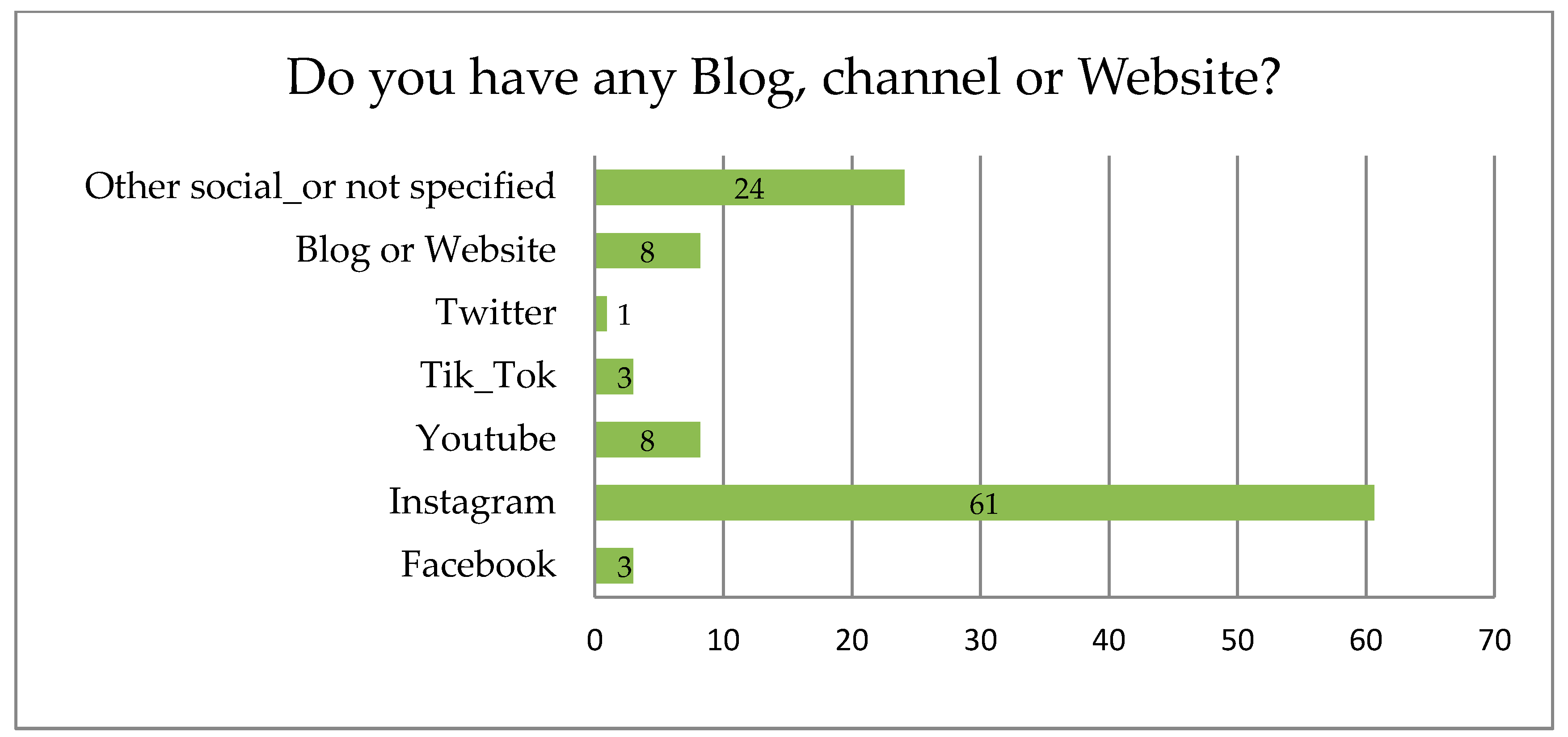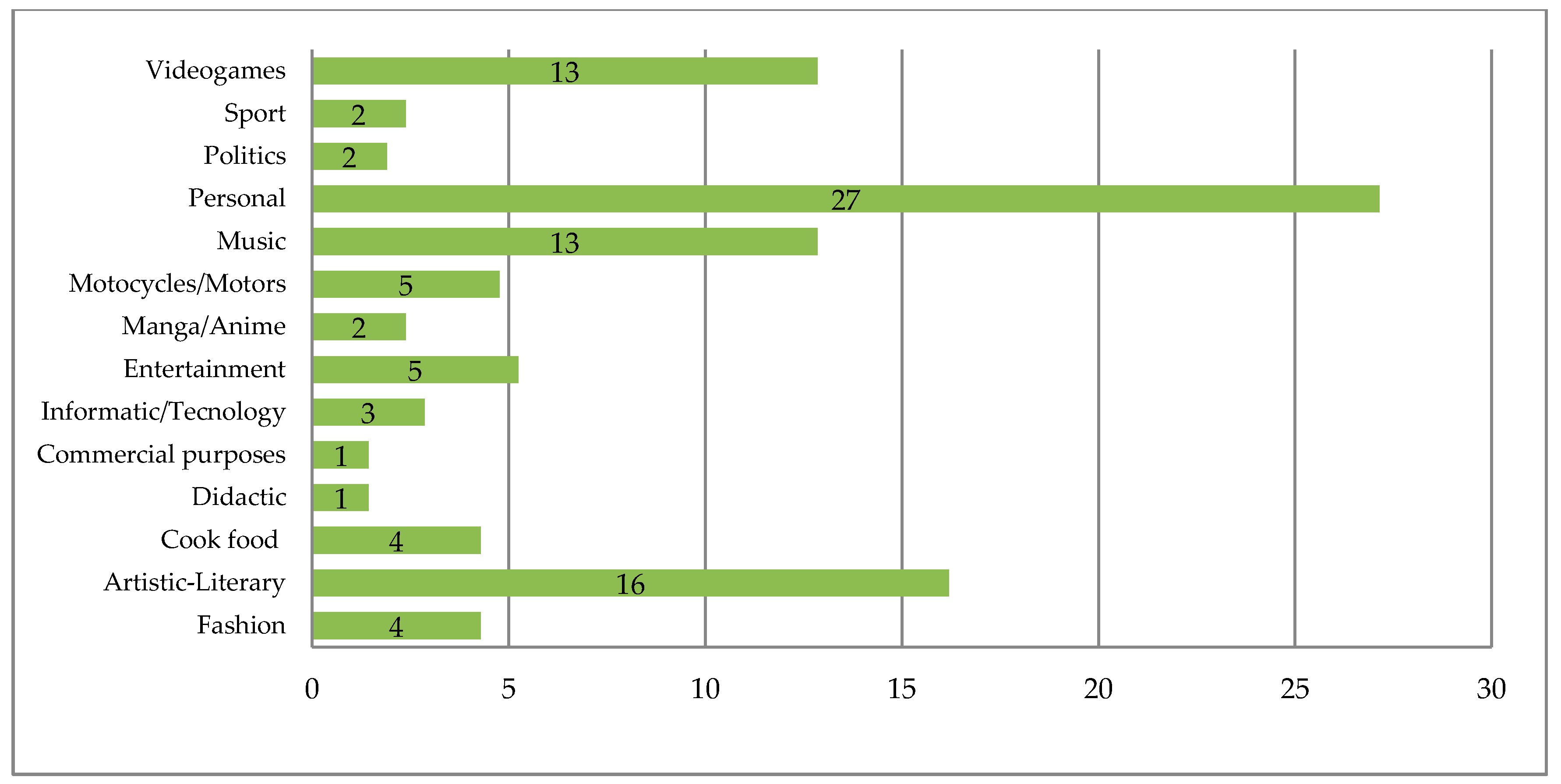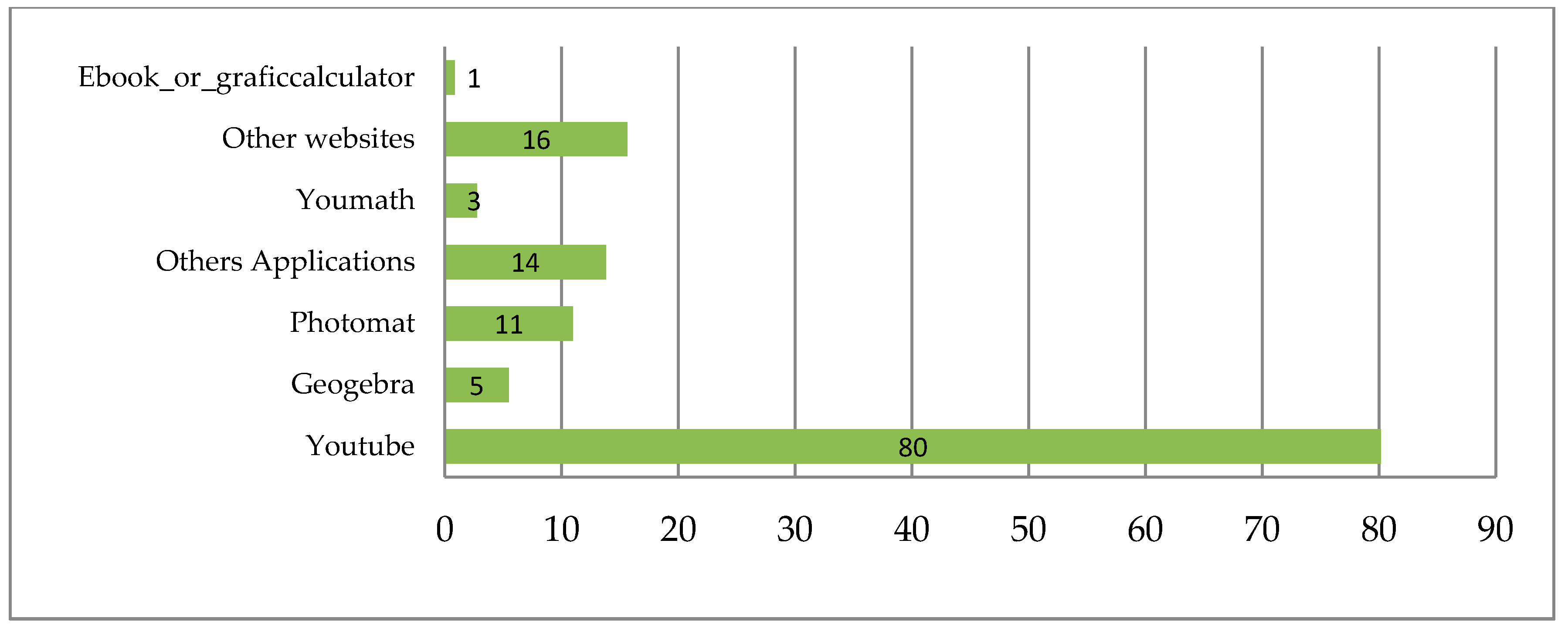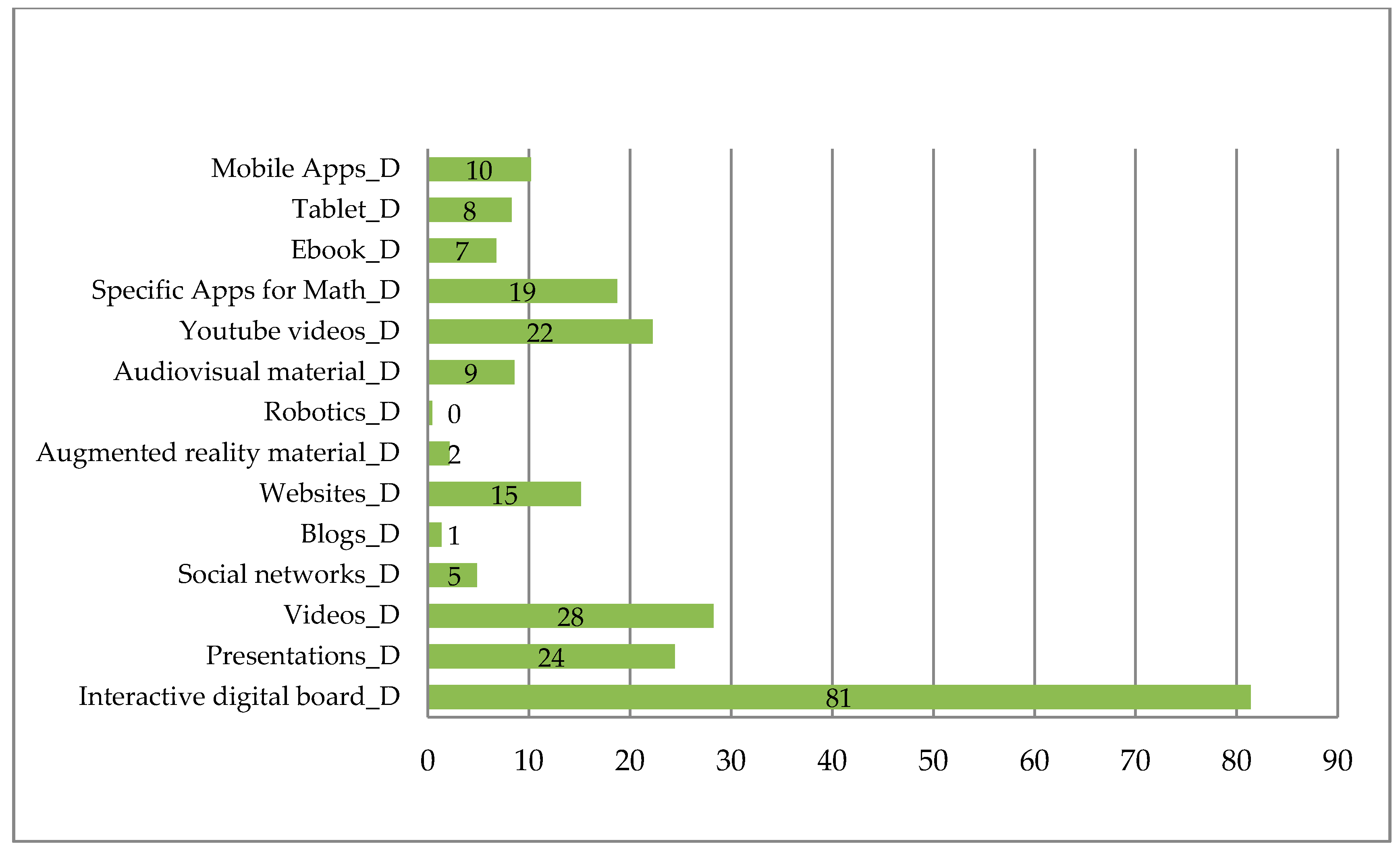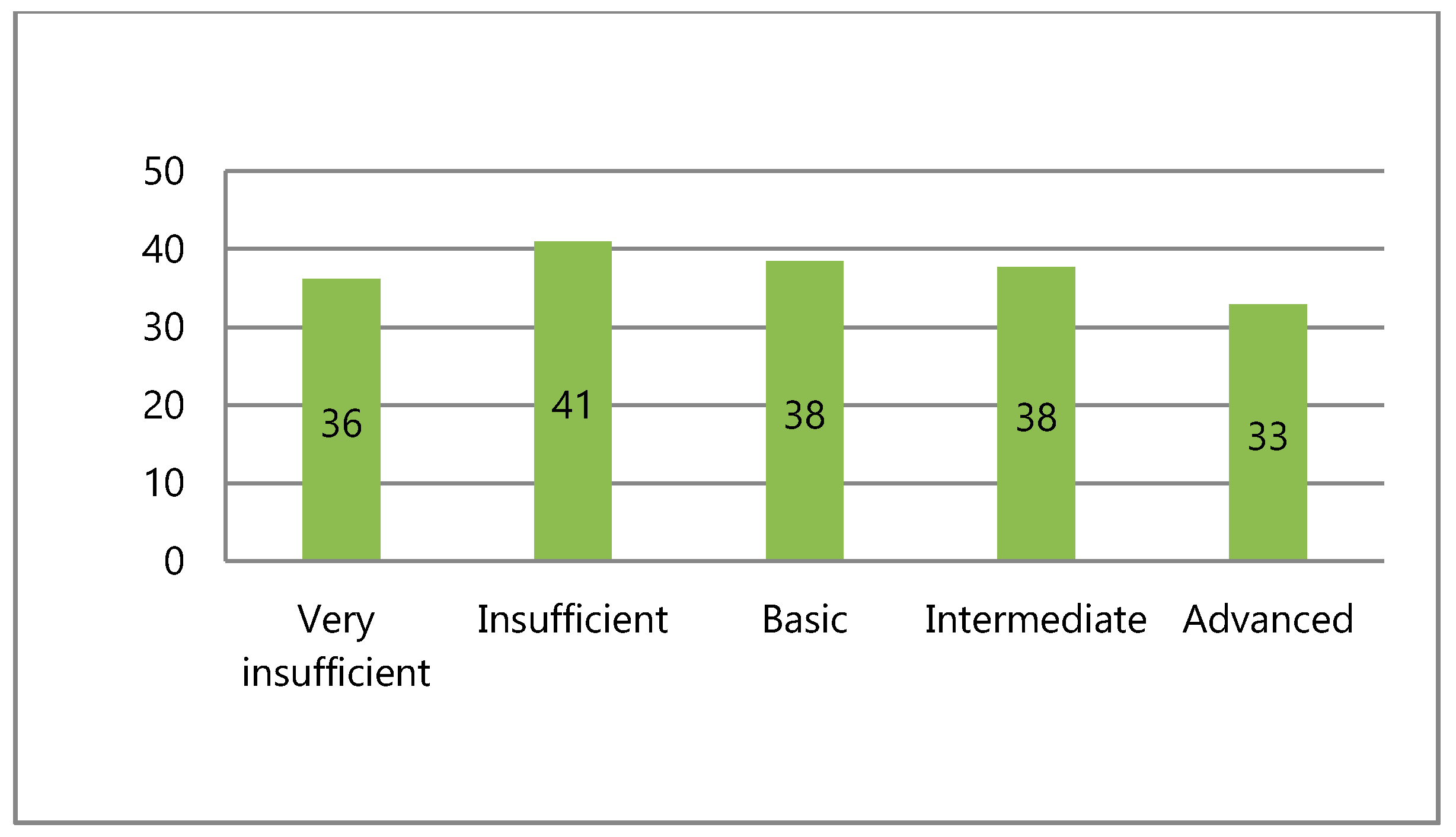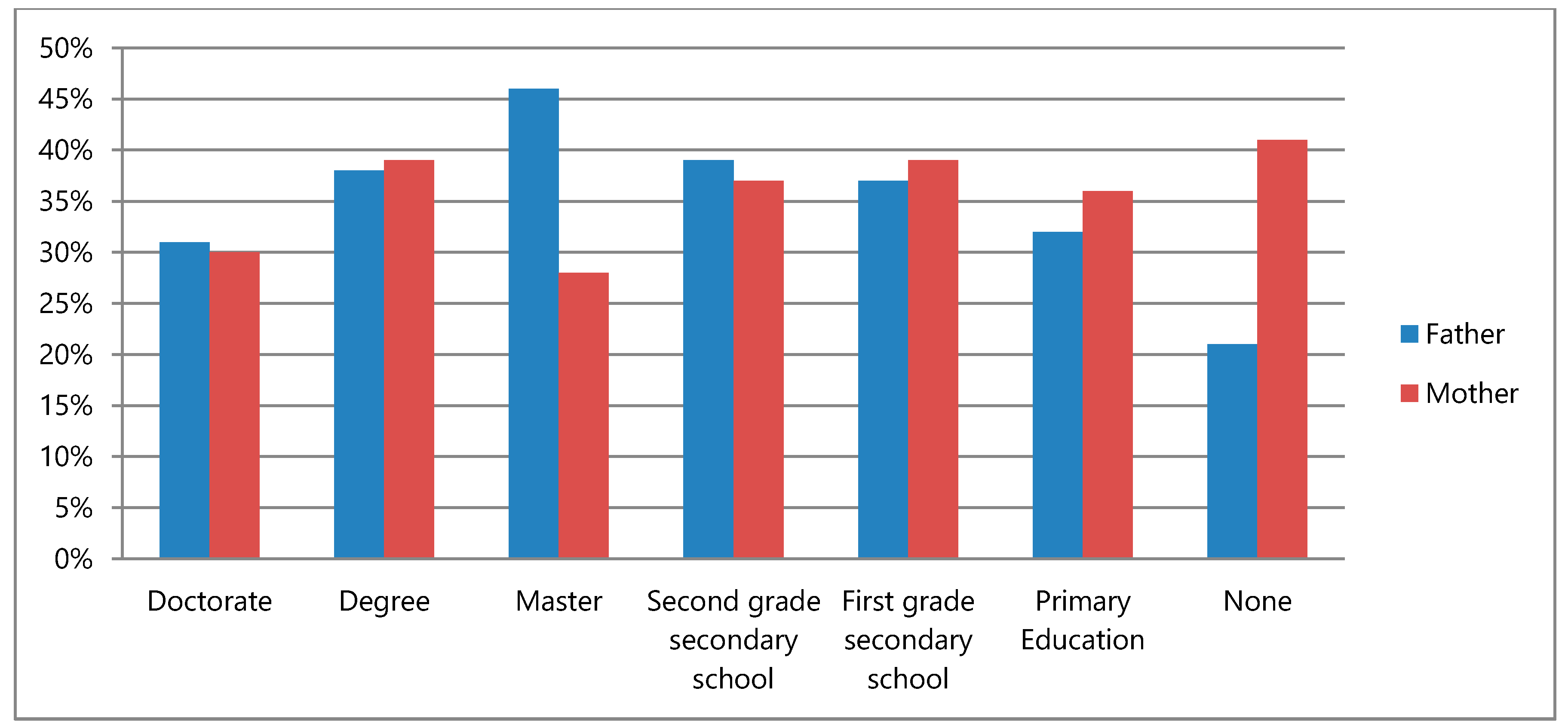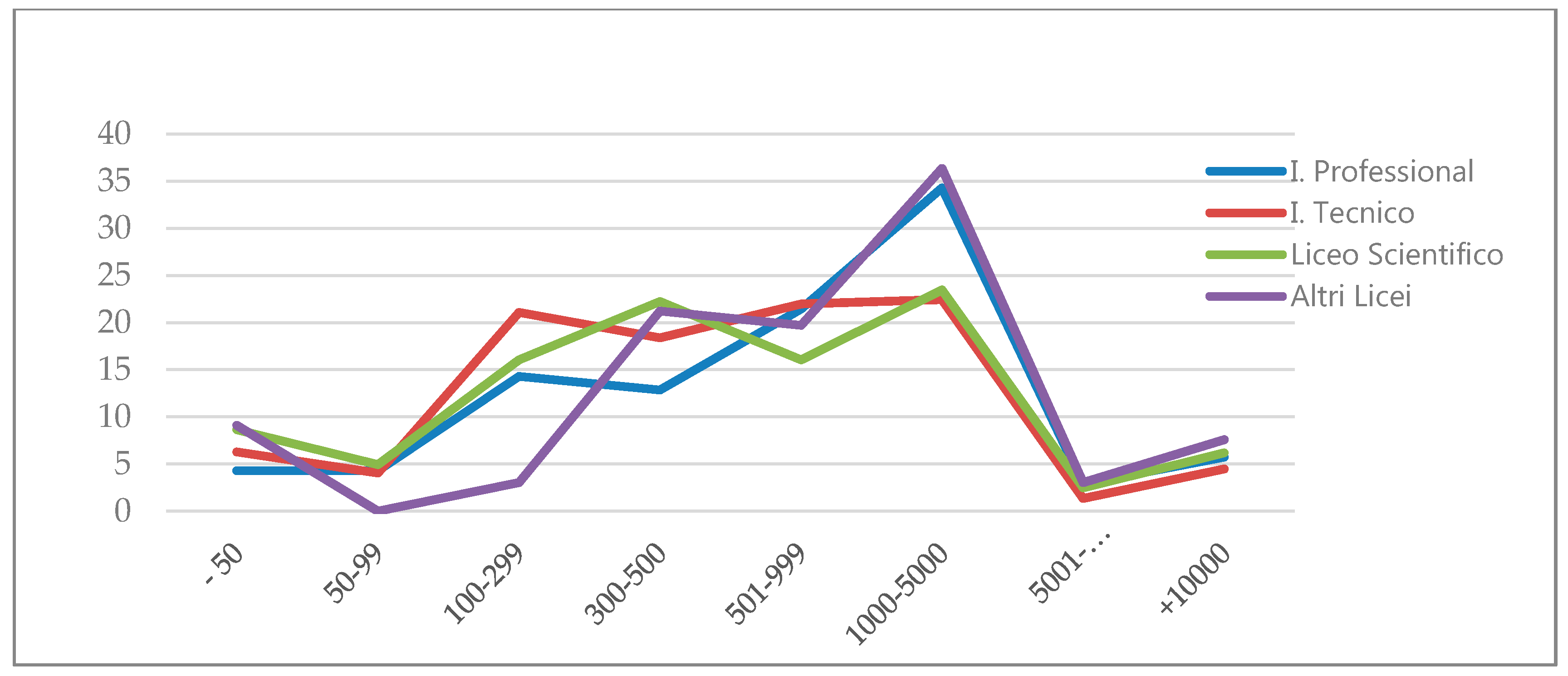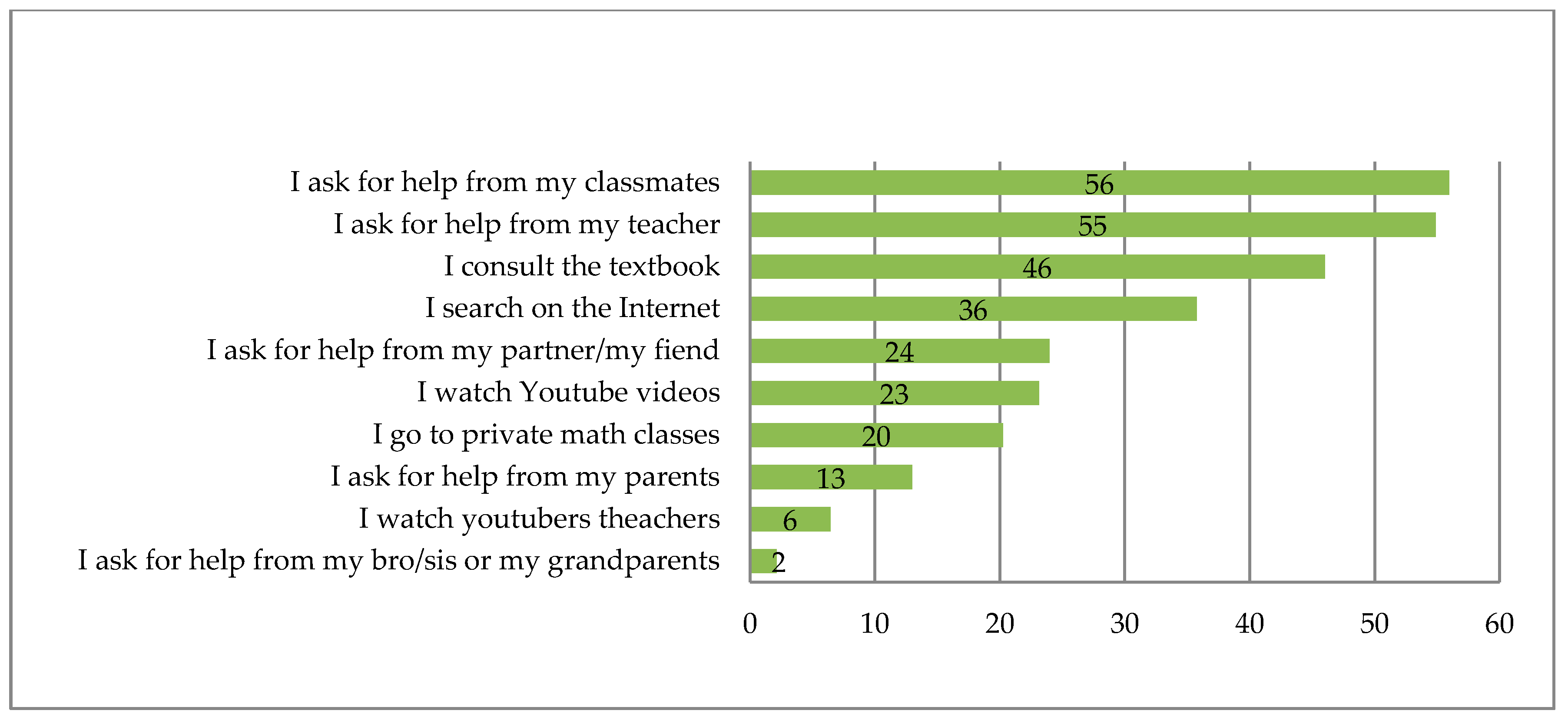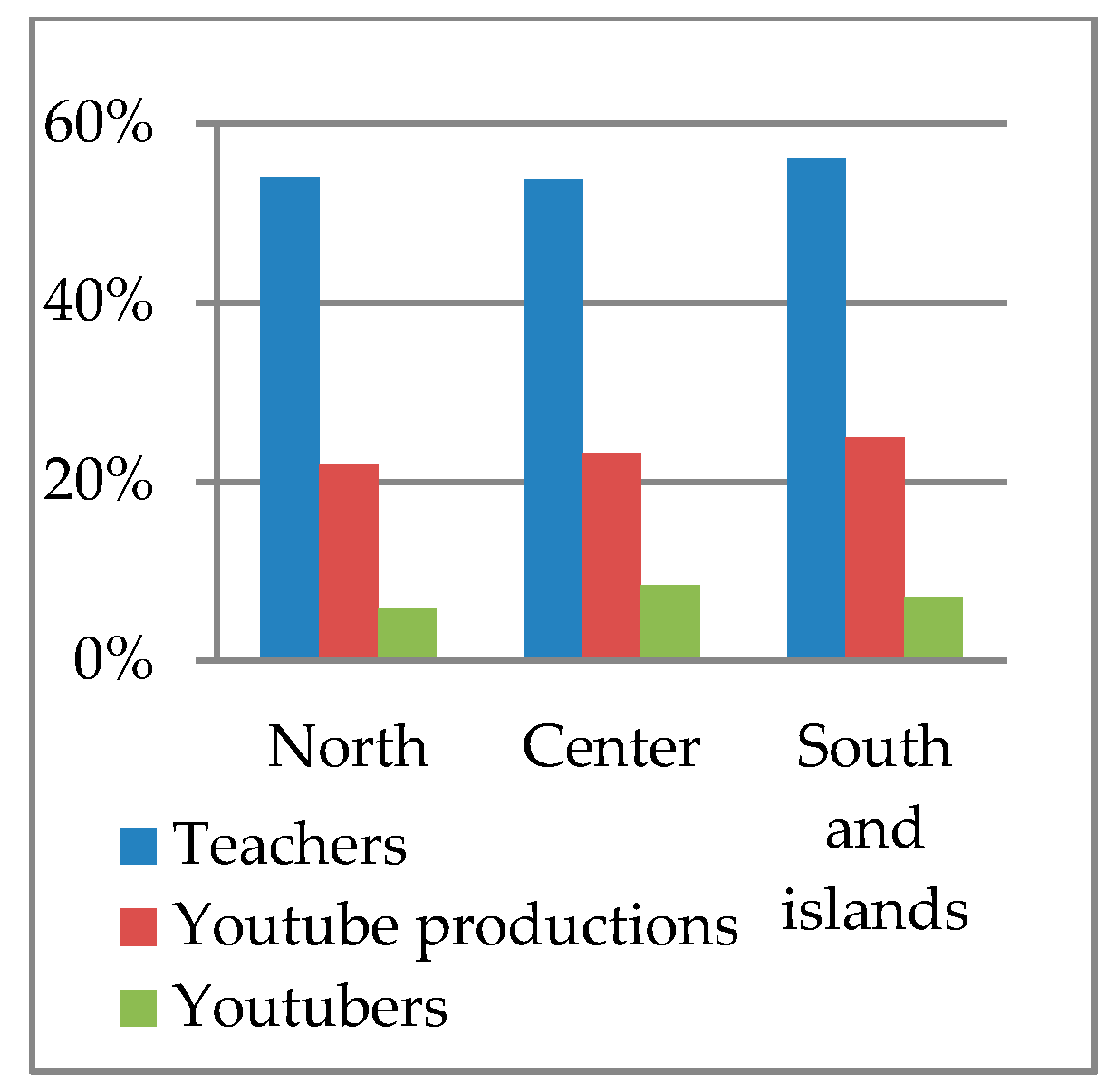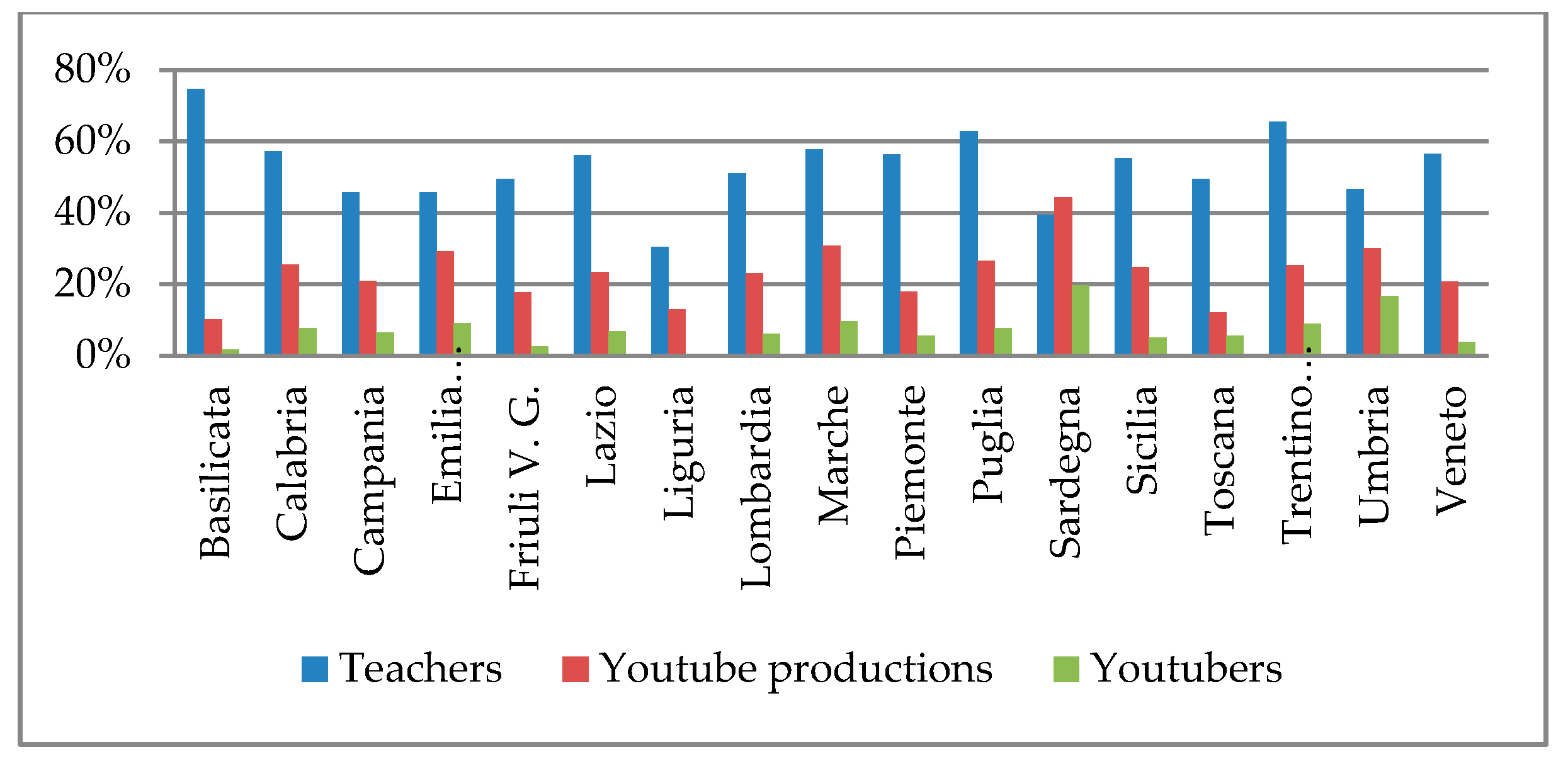1. Introduction
The adolescents of the second decade of the 21st century have been formed in the context of “digital savants” [
1], interacting in different spaces where participatory culture is developed with high potential, featuring user communities where they project their role as contributors and prosumers. Consuming, producing, and creating content is the daily life of these subjects that is projected through the multiple screens developing not only digital skills but also an interactive, lively, active, and social learning process [
2]. The future challenge for all of them is to become influencers and live to have followers in their networks and transform their relationship model in a digital space with other interacting people in comments, direct, likes, or dislikes. This is the reality of participatory culture where digital technologies, media convergence, and the fluidity of learning have brought about significant changes in the lives of citizens [
3].
This social context opens the door to a change that affects learning and communicative and pedagogical models. Influencing adolescents by fleeing from ‘liquid spaces’ brings face-to-face teachers and influencers, both opinion leaders with fundamental roles in this stage of development and personal identity. For this reason, it is essential to investigate this phenomenon in order to understand its scale and trends.
The relationship between learning and Information and Communication Technologies (ICT) has been a subject that has been studied extensively in the late 20th and early 21st centuries. This study, on the other hand, does not aim to respond to this area of education and communication, but rather to cover an innovative issue such as the perception that adolescents have of the teachers in their educational centers and the influencers that they follow on their social networks, specifically on YouTube.
In this sense, this research seeks to diagnose the role of culture, digital resources, social networks, and, specifically, YouTube, in learning processes and the acquisition of Science, Technology, Engineering, and Mathematics (STEM) competencies. To meet this objective, the role of youtubers and, in contrast, of teachers, both learning leaders in the formation of these skills, will also be examined. The decision to analyze the impact of the influence of the YouTube platform and, specifically, of the youtubers on the acquisition, within the STEM competencies, of mathematical competence, is due to the difficulty that this discipline traditionally entails in the learning processes at the high school stage. As a practical implication, this research will enable teachers to better understand the world of digital learning, mathematical competence in adolescents, and the influence of social networks in supporting learning in formal and non-formal contexts.
The study has been developed through a mixed methodology based on the realization of a questionnaire to 4845 Italian adolescents, analysis of the discourse of 12 in-depth interviews with secondary school teachers and 15 productions made by the youtuber EliaBombardelli, in addition to the evaluation of the impact and digital engagement of his influence.
Thus, the present study is based on the hypothesis (
h0) that YouTube is a useful and effective tool in the students’ learning process, understanding that provides significant advantages to the teaching practice in the acquisition of STEM competencies, enabling the access to students with learning difficulties [
4]. These new opportunities reflect the value of YouTube and the new channels dedicated to the diffusion of knowledge as an emerging informal means of scientific literacy, transmitting knowledge to adolescents [
5]. Thus, youtubers have become a vital component in young learners’ education, and are valued by adolescents more than their teachers, although they still prefer to interact with them in face-to-face spaces.
2. Materials and Methods
The methodological approach followed in this study is based on the combination of quantitative and qualitative techniques, that is, through a mixed design, with an exploratory-correlational scope. Concerning the quantitative design, the instrument used for the collection of data has been the questionnaire, completed by 4845 adolescents living in Italy in a total of 75 of the 80 provinces. According to data from the Istituto Nazionale di Statistica [Italian National Institute of Statistics], the youth population (between 11 and 15 years old) is 2,854,720 by 2019, so the sample selected for this study exceeds the required number to obtain a confidence level of the results ≥99%, with a margin of error of +/−2%, so from the data collected—also taking into consideration the geographical distribution—it will be possible to make descriptive inferences.
The questionnaire has been elaborated following the criteria of the Likert scale technique, offering a clear statement to the subject [
6,
7], some questions with concrete answers, others open, and others with multiple responses. After analyzing the reliability statistics, Cronbach’s α offered positive results with a value of 0.802. The defined variables present a distribution that resembles the Gaussian bell, which confirms the normality of the defined latent variables. In addition to the questionnaire, the web application
Influencity has been used in order to analyze the impact on EliaBombardelli’s social networks.
Finally, the qualitative methodology [
8,
9,
10,
11] has focused on the discourse analysis [
12,
13,
14] of 12 in-depth interviews with the participation of teachers from the secondary schools where the adolescents in the sample study, on the one hand, and of 15 productions made by Elia Bombardelli on YouTube, on the other. Within the sample, the choice was made to study the field of mathematics because it is a subject that has particular difficulties and because it is one of the STEM (Science, Technology, Engineering, and Mathematics) competencies that are intended to be promoted in Europe and the USA in order to foster competitive economies in the future.
In order to specify the purpose of this study, the following questions are addressed: [RQ1] Who do the students go to when they have concerns about maths? [RQ2] How would they rate the math teacher, and the youtuber? [RQ3] During maths lessons, do teachers use digital resources? [RQ4] Do teachers have a blog, website, or YouTube channel? [RQ5] What are the most useful digital resources, according to students, used by teachers during math classes? [RQ6] Do adolescents have any digital resources that help them understand maths? [RQ7] Do they have a youtuber on social networks to learn math? If so, what or who are their favorites? How would they rate their youtuber? Furthermore, if we think about the digital production of adolescents, [RQ8] do they have a blog, web page, or YouTube channel on some topics (in general)? How many followers do they have?
The questions outlined [RQ] turn into objectives that make this research concrete:
Objective 1: Diagnose the relationship between the participatory culture of adolescents and the processes of learning and acquisition of STEM competencies.
Objective 2: Find out the digital resources and social networks most used by adolescents and their teachers in their process of learning and acquiring STEM competencies.
Objective 3: Analyze the role of youtubers as learning and support leaders in the formation of adolescent STEM competencies.
The formulation of these objectives corresponds to a study that has been designed to approximate observable phenomena. Likewise, the following hypotheses have been contrasted and formulated using a hypothetical-deductive method, related to the objectives of the study:
Hypothesis (H1):
Italian adolescents create their digital spaces and are prime users of Instagram and consumers of YouTube.
Hypothesis (H2):
The interaction in social networks by adolescents involved depends on academic performance, age, and school context.
Hypothesis (H3):
Italian adolescents, unlike teachers, value YouTube videos as the most useful resource in the process of learning and acquiring STEM skills.
Hypothesis (H4):
The use of YouTube videos as a resource in the learning and acquisition of STEM competencies does not depend on gender, age, rural/urban area, region, family level of study, or academic performance, but does depend on the type of school.
Hypothesis (H5):
Italian adolescents rate youtubers over teachers.
Hypothesis (H6):
Teachers and youtubers play, in the teaching of STEM competencies, the variables of clarity, variability, enthusiasm, task orientation, opportunities for the student to learn.
2.1. Participants
The participants in the surveys were 4845 adolescents residing in Italy with ages ranging from 13 to 22 years, with an average age of 16.43 years. Fifty-two percent of the respondents are female and 48% male. The provinces of residence reached were 75 out of 80, in all geographical extremes of Italy: North (60%), Centre (7%), South and Islands (33%). The sample from central Italy was not intentional, and teachers from all three areas of the country were asked to participate, but many preferred not to provide the questionnaire because students were already loaded with distance activities due to the COVID-19 pandemic. The adolescents interviewed live in more than 800 different localities, 66.6% are in rural areas, and 33.4% in urban areas.
The teaching teams that participated in the interview were 12 from the area of mathematics (STEM subject) from Italian secondary schools. Seventeen percent of the participants were male, and 83% were female, aged 32–59 years, with teaching experience between 2 and 33 years. It is of vital importance for this study on the acquisition of STEM competencies that 42% of the interviewed persons are graduated in Mathematics, 25% in Statistical Sciences, 17% in Physics, and 8% in Economics and Computer Engineering. Geographically, 58% of the interviewed individuals live and work in Northern Italy, 8% live in the Centre, and 34% come from the South and Islands. Also, part of the sample is the Italian influence Elia Bombardelli, whose impact, engagement, and productions will be analyzed.
2.2. Process
The quantitative approach, corresponding to the questionnaires applied to Italian secondary school adolescents, and the use of qualitative methodologies, through semi-structured interviews with second-grade secondary school mathematics teachers, make possible the analysis from both perspectives that enrich the process. Mixed methods specific to the social sciences are applied by combining “quantitative or qualitative research techniques, methods, approaches, concepts, or language in a single study” [
15] (p. 17). This makes it possible to gain a better understanding of what we are studying, to cover the strengths of both methodologies, and to analyze different approaches, combining the data to obtain converging results [
16].
For the surveys, a questionnaire was created in Google Forms, sending the instrument to the Italian educational centers, asking for their collaboration for this research. Once the necessary data were obtained, they were analyzed. First, for the quantitative analysis, the csv data were exported to an Excel file for further interpretation with the statistical package IBM SPSS v. 25. Data were entered into the software by assigning numerical values to the answers obtained in the questionnaires, filtering and debugging, selecting the appropriate procedure to calculate the statistical data, and running the procedure to obtain the research reports. While the teacher interviews have all been conducted via Skype, the analysis and data collection related to the objectives and assumptions were subsequently carried out. Finally, through YouTube and the web app influencity, it was possible to analyze the impact and the productions produced by EliaBombardelli.
2.3. Instruments
For the quantitative section, we opted for the design of a questionnaire structured in closed, open, and multiple-response questions, validated by researchers from the SMEMIU group of the National University of Distance Education (Spain). The independent variables were: Gender, age, city, area, the zone of rural/urban residence, type of school, course, academic performance in the current year, and parents’ level of studies. Various perspectives were considered as dependent variables that allowed us to respond to the questions [RQ], objectives, and hypotheses presented in the study.
To address the qualitative approach, a semi-structured interview was designed, collecting personal information such as gender, age, city of education, years of experience as a teacher, current school typology, and years of teaching at the current school and level of education. Using Google Forms, informed consent was developed for interviewees to give their consent for the interview to be recorded. During the interview, the participants were asked to respond freely, avoiding interrupting their interventions, although, at certain times, it was decided to focus on some elements in order for the subject to give a more precise response.
In order to make quick and simple references to the interviews and to differentiate the contributions of each of the persons interviewed, the codification has been chosen: E-Tnº:pag. In this coding, we refer to the interview (E), the teacher (T), the number of the interview referred to (nº), and the page where the referred event can be found (pag). Therefore, if during the analysis, we want to report information that appears on the first page of the interview with participant 1, this is coded as follows: E-T1:1.
In order to analyze the impact on EliaBombardelli’s social networks, we use the influencity application as a research tool, and we examine the productions in comparison with teaching variables (clarity, variability, enthusiasm, task orientation, student’s opportunities to learn), making a record in an observation table.
2.4. Ethical Considerations
The sample involved in the qualitative and quantitative techniques is distributed as follows: 12 people in the in-depth interviews and 4845 adolescents both from Italian secondary schools. The completion of the questionnaires, like the discourse of the interviews, was transcribed for the categorization of the resulting narrative, respecting the anonymity. All the subjects surveyed and interviewed were informed about the objectives of the study, the institutions that endorse it, and its voluntary nature. Not only was anonymity advocated, but also the confidentiality of the data. Finally, a methodological triangulation and comparison of the survey data with the results of the discourse analysis presented in this study were established, respecting all participants.
2.5. Reliability
This criterion determines whether the instrument’s measurement scales are accurate, with reliability being understood as the precision of the instrument, taking into account the possible errors found in the exploratory factor analysis (EFA). The lower these errors are, the higher the accuracy of the measurement. To study the reliability of the instrument, we have followed the procedure of the Cronbach α. After analyzing the reliability statistics, it can be said that, in all five cases, Cronbach’s α offers positive results with a value of 0.802. From the study of the histograms of normality obtained, referring to the defined latent variables, it can be said that all of them present to a greater or lesser extent a distribution that resembles the Gaussian bell, which confirms the normality of the defined latent variables. Some deviation can be observed, although it is not significant in any case, which allows advancing from a parametric point of view of reliability with the investigation.
3. Results
3.1. Category 1. Relationship between Adolescent Participatory Culture and STEM Competencies Performance
The study shows that adolescents manage a blog, a website, or a social media site on some topics and have a high number of followers. Sixty-one percent declare to have Instagram as their social network of reference, as can be seen in
Figure 1. Only 8% have their own YouTube channel, a remarkable fact because of its extensive use in individual learning processes. YouTube is positioned as a social network that adolescents consume, but that, in Italy, is not yet positioned as the preferred one for creating or sharing its content production channels.
The topics that arouse the highest interest in Italian adolescents who use social networks, as we can see in
Figure 2, are Artistic-Literary (16%) and Video Games (13%). At a participatory level, there is also interest in using social networks as a personal space (27%) to publish issues related to their interests and hobbies.
In subject preferences, the Artistic-Literary field is preferred by 79% of female versus 21% of male. The second in preference, referring to video games, shows 96% who choose this option is male, compared to 4% female. In general, male users are active in the participatory culture by having a blog, a website, or a YouTube channel by 65%, compared to 35% of women. Due to the geographical distribution of the topics covered, there is a moderate correlation between topics covered and macro areas (0.35). In the north of Italy, a higher percentage of young people have personal websites; in the centre of the country, a lower percentage has video games, while in the south, the three topics are equally treated (
Figure 3).
Having followers in social networks is one of the interests of adolescents who live immersed in participatory culture. On this point, as shown in
Table 1, half of them have between 500 and 5000 followers, 80% between 100 and 5000, having an interesting position in social networks.
To conclude this category, as can be seen in
Figure 4, an association is highlighted between having a blog, website, or YouTube channel and the performance of STEM competencies, specifically in the area of mathematics. Students who have many followers have lower academic performance.
It is also possible to observe the emotional character of the networks where adolescents with low academic performance have in their profiles a personal space for self-realization (
Figure 4). As it can be observed, adolescents with more followers (≥5000) are the ones who have inferior performance in mathematical competence.
3.2. Category 2. YouTube Top Resource for STEM Competencies
Among the social networks that students can access for the development of STEM competencies, specifically mathematical competence, YouTube stands out as a leading social network, as shown in
Figure 5. Although the use of applications (apps) is positioned in the sample by 14%, and other programs such as Photomat (11%), Geogebra (5%), or Youmath (2%), YouTube is the platform preferred by 80% of students as a learning media.
The data presented in
Figure 6 show that 35% (multiple choice questionnaire) of the adolescents surveyed have learned in the classroom from this social network. In contrast,
Figure 7 shows that the same resource is used by only 22% of teachers, according to the students.
In this sense, the presence of YouTube is confirmed as a critical resource in the acquisition of STEM competencies, although its space for interaction is shared outside the classroom. On the other hand, the sample shows that 24% of teachers use presentations, and 28% use another type of video (
Figure 7). Although 81% of teachers use the Interactive Whiteboard (IWB), it is understood that this resource is complementary to the previous ones.
These data are also supported by the information obtained in the interviews with the teachers, who admit to using the IWB: [I try to use it as much as possible, at least in each lesson (S-T1: 1); I use it a lot in the triennium (16–19 y/o) and less in the biennium (14–16 y/o), or to propose the exercises Invalsi (first, second, fifth year), by Geogebra with the study of the function or functions in two variables (S-T3: 12); the IWB; I use it each lesson (S-T5: 22); in each lesson and sometimes also the graphic calculator (S-T10: 41)]. Of the teachers interviewed, only two admit to relying on audiovisual material: [I often use videos and animations and programming environments such as Scratch. While I always use didactic software like: GeoGebra, GraspableMath, Socrative, LearningApps (E-T8: 33); For some demonstrations and exercise guides, I use the resources of Zanichelli’s books through Booktab on the IWB. Occasionally I use several resources I find on YouTube (E-T9: 37)].
Compared with the responses of the students, it can be observed in the study that the digital resources most used by the teaching staff are not the ones that the students consider most effective. The resources that students consider most effective, such as videos, chosen by 72% of participants, have a 50% use rate by teachers. Specifically, YouTube productions are chosen as a top resource by 35% of teenagers and 22% of their teachers.
There is a moderate correlation of 0.36 between students using YouTube productions as a resource for STEM competencies in non-formal education and the perceived use of YouTube productions as a useful resource in schools. In this regard,
Figure 8 clearly shows that there are no differences in performance between students who use YouTube as a learning resource, with both students with a deficient academic performance and those with an intermediate academic performance level viewing videos.
It should also be noted that there are no differences between students using YouTube with residence in a rural or urban area, nor are there differences in gender. Geographically, the percentage rises from 23% in the Friuli Venezia Giulia region to 47% in the Umbria region, and there is no difference in terms of macro-areas (
Figure 9).
Using YouTube videos as a digital resource for learning mathematics also does not depend on the level of study of the parents. Both adolescents whose parents are graduates and adolescents whose parents only went to elementary school use YouTube as a resource (
Figure 10).
As can be noted in
Table 2, although the contingency coefficient is close to 0.5 for both mothers and fathers (which would mean a strong correlation between the two variables), the significance of both is greater than 0.05, which means that the null hypothesis is rejected, since there is no association between the non-nominal variables of family academic level and youtube consumption preference.
As a school typology, among the students who use YouTube most as a digital resource for learning mathematics, the highest percentage come from technical institutes such as science lycées [Liceo Scientifico] (41%), being a resource less used by students from other high schools and by students from professional institutes. From another point of view, more adolescents with many followers/visualizations in their digital spaces are enrolled in professional institutes or other high schools (
Figure 11).
3.3. Category 3: Learning Leaders: Adolescent Preferences
Mathematics is, within the STEM competencies, the one that presents more difficulties at this stage of the Italian education system [
17]. Building on the promotion of a participatory culture valued in this study, it is essential to examine the role of social networks, and especially of youtubers as learning leaders, a blunt line that links learning in formal and non-formal spaces.
In this regard, it can be seen that the role of youtubers, which are projected as possible ‘substitutes’ for teachers in this discipline in the coming years, takes on particular relevance. Although 55% of students still prefer to ask teachers (multiple answers) in face-to-face learning environments, 36% look for answers on the Internet, 23% choose to view content on YouTube in general, and 6% confirm that, among these videos, they view those produced by youtubers.
Thus, the Internet is presented in 36% as a learning environment, and YouTube is projected in 29% of the sample as the social network of preference for the development of individualized learning processes based on STEM competencies. The role of interaction with other classmates in the learning process is significant (peer tutoring), using other social networks in the communicative process, as detailed in the interviews conducted, 56% ask for help from their peers in the completion of school tasks, using social networks as a communication tool. This shows that social networks are making inroads in the time dedicated to studying in Italian homes, although the textbook still has strength, occupying 46% of the respondents (
Figure 12).
Another significant fact is that there is no gender difference in viewing YouTube videos for math literacy. In terms of age, 47% of students who watch YouTube videos are between 17 and 18 years old, while 49% of students who watch YouTube teachers have the same age range. Students in the age group 16–19 view more videos on YouTube than those in the age group 14–16, related to mathematical competence (68%), and consult Youtubers teachers (71%). This is corroborated by noting the age range of followers of the most followed teaching-youtuber in Italy, Elia Bombardelli. The opposite happens when it comes to having a blog or a website, an initial step to the participatory culture as influencers, where the students of the age group 14–16 are more numerous (57%).
In Italy, at the macro-area level, the situation is not very different. Asking teachers for help with doubts in the learning process is one of the most widespread attitudes among Italian students, as shown in
Figure 13. Italian adolescents still prefer teachers to youtubers. Although there is an exceptionality at the regional level, as shown in
Figure 14, as in Sardinia, there is a trend contrary to the national one, i.e., the preference is for youtubers over teachers in schools.
The role of Youtubers is becoming more important for the realization of academic tasks at home and, within these, there is also a projection as influencers who have a more significant impact on users of the network. It is noteworthy, as detailed in
Table 3, that 52.4% of the students who stated that they consulted youtubers as support in the acquisition of STEM competencies, such as mathematics, did not remember the name of the youtuber professor they consulted. It has been possible to verify that different youtubers are presented in the study such as LaFisicaCheciPiace, Matematicale, AgostinoPerna, etc., with the youtuber EliaBombardelli being the one that positions itself as an influencer in this area of expertise, being elected by 49% of the surveyed students (
Table 3).
Elia Bombardelli has 299,000 followers on his YouTube channel, 70.22% male and 29.78% female, aged 18–24. He aroused engagement among his followers of 10.38%, 31.04 k interactions, an average of 30.35 k views, 643 likes, 33 comments, and 12 dislikes, as shown in
Table 4. In the videos generated, the reading of the base text of the subjects Linear Algebra I and Linear Algebra II of the Grade in Mathematics is sequenced. The students very much appreciated these videos. In the first term subject, with an enrolment of more than 700 students, the videos of the first subjects have had more than 1000 views per course.
Another aspect to highlight in this study is the rating that adolescents give to their teachers in comparison with the youtuber, as presented in
Table 5. It can be seen that the teachers are evaluated with an average grade of 7.84/10, and the youtuber receives a grade of 8.32/10. This fact is very remarkable, since the communicative model used by youtubers, the interaction with their followers, and the degree of empowerment they give them in their visualizations, comments, and other interactions, make it an academic reference for the students.
Academic performance in the acquisition of mathematical competence in Italian students is correlated with the grade students give to teachers. As shown in
Table 6, there is a moderate (
r = 0.361) and statistically significant correlation in
p = 0.000 < 0.05. This performance is not conditioned, but by the note they give to their preferred youtuber, with a positive-weak correlation (
r = 0.050), significant at level 0.05. Studying the educational context, a strong correlation (.605 Spearman’s Rho) between performance in mathematical competence in the course when the study was conducted (2019/2020) and performance in the previous course (2018/2019) is highlighted. There is also a moderate correlation (0.36) of these data with the grade given by the students to the teachers.
Five variables were taken into consideration to be a good teacher [
17], which are: Clarity, variability, enthusiasm, task orientation, and student opportunities to learn. Teachers have been asked if, in their opinion, these variables are revealed by comparing them with the most frequently used youtuber in Italy, Elia Bombardelli. As can be seen in
Table 7, almost all the teachers interviewed stated that they put these five criteria into practice.
Analyzing, through the analysis of content (qualitative), 15 productions of the youtuber, removing the orientation to the task, he surely has clarity and enthusiasm. He offers opportunities to learn, but he does not have variability because he is not in a face-to-face way with the students. Thus, it can be seen in
Table 6 that X is affirmative, x/y is dubious, and z is negative. His clarity is expressed through a low tone of voice, speaking slowly, and offering students the steps (rules) to follow to develop a typology of exercises.
It can be added that, as he admits, he does not explain some “why” of what he does, presenting this competition as more practical than theoretical. In the analysis of his productions, it can be considered that self-motivation is a circular process, being necessary for students to begin to think that they are “capable of achieving it”, and then to work on the “why” and the “where”.
As for the opportunities to learn that he can have as an influencer, these come from the characteristic of an asynchronous production, that is, the possibility of listening to him as many times as needed, achieving in this way a greater understanding in the acquisition of STEM competencies. This final fact is important because it helps to understand the students with particular difficulty who, in the classrooms, due to the subject of the emotional aspect of their shyness, are reluctant to ask if they have not understood something during the teacher’s explanation in front of their peers.
4. Discussion and Conclusions
The 2016 Report of the World Economic Forum [
18] estimates that 65% of the current school population is destined to find a job that does not exist. Italy does not manage to make the most of its human capital, not being an ideal country to grow and develop the talent of the population in lifelong education. That is according to the 2016 Human Capital Index ranking compiled by the World Economic Forum.
Italy is in the next-to-last place among the main industrialized countries, only surpassing Spain and, in the ranking of the big names, is also surpassed by Greece. Finland is first in the ranking thanks to the ability to develop young talent. Why do these differences exist, what can we do, and how can we help Italian teenagers?
Among the main weaknesses, in the field of STEM competencies of Italian adolescents, we find mathematical competence. This information is presented by the Istituto Nazionale per la Valutazione del Sistema Educativo di Istruzione e di Formazione [National Institute for the Evaluation of the Education and Training System of Italy], placing level 3 as the one corresponding to an adequate achievement of the objectives of the National Indications/Guidelines. The percentage of students reaching or exceeding level 3 in upper secondary mathematics in 2019 is 78% in the northeast and 75% in the northwest, falling to 63% in the center, just above the national average of 62%, and falling further to 49% and 43%, respectively, in the south and the islands [
19].
More than half of the students in these two geographical areas, therefore, remain below level 3. How does the Italian education system need to change in order to develop the country’s human capital? Can teachers change anything to help them? What role do YouTube and influencers have in this change? Mathematical competence has a fundamental role in the development of critical thinking, avoiding the influence of the entertainment industries that want to subject an individual to passivity [
20].
This study has shown how Italian adolescents create their own digital spaces such as blogs, web, profiles in social networks, and, from the age of 17, increase their production and creation through YouTube channels, a previous step in the assimilation of influencer culture. As collaborative creators [
6], adolescents in Italy have Instagram as their preferred social network, with a number of followers between 500–5000, where they develop their communication skills and create knowledge around themes related to the artistic and literary field, personal production around their leisure time, and video games.
Being involved in the participatory culture makes interaction in social networks a resource for learning, having a higher projection in spaces outside the classroom [
21]. Italian teenagers with a lower academic level interact more consistently on social networks and have a more significant number of followers. This difference can also be seen in those who are enrolled in professional institutes or high schools. The social web has a unique function in peer tutoring, being projected as a communicative tool in order to carry out daily classwork from the family home [
22].
YouTube is presented to Italian adolescents as a resource in the learning and development of STEM competencies [
23] that present great difficulty both in the syntax and in the semantics of the mathematical discipline. Whether or not they are academically successful, male or female, living in one region or another, all adolescents value YouTube videos as a critical resource for improving performance [
24,
25]. This perspective is valued both by individuals whose family has an average level of academic training and those who have a high academic level. The use of YouTube videos in these processes does not depend on gender, age, rural/urban area, family level of study, or academic performance, but on the type of school and the Italian region concerned.
Teachers or youtubers? Italian adolescents rate youtubers above teachers. On the other hand, it is striking that in the processes of learning and acquisition of STEM competencies, they prefer to interact with teachers rather than with youtubers. This appreciation cannot be generalized to all Italy: The region of Sardinia shows a contrary trend to the national one; that is, adolescents prefer youtubers to the teaching staff of the schools.
This research also shows that academic performance in the acquisition of mathematical competence in Italian students is moderately correlated with the grade students give to teachers. However, this correlation is significant when they set the grade they give to their preferred youtuber [
26].
As far as the educational context is concerned, there is a moderate correlation between performance in mathematical competence and the score with which the students have assessed the teachers as stated in a previous study [
27], which had the objective of finding out the main difficulties in the teaching and learning of algebra that a group of teachers of mathematical competence reported having. The first difficulty that this research highlights is the inadequate foundation that students bring from previous grades. This aspect of STEM competencies is essential, as a common thread connects them.
This assessment not only justifies the strong correlation of academic performance, but could also explain the higher score for youtubers. This fact is significant because to refer to the social web is to talk about expanded, liquid, and ubiquitous reality, where the students have access at any time of their daily lives. Even the productions of the youtubers can be visualized by those students who, for reasons of shyness or embarrassment, limit their participation in the classroom.
The role of youtubers is also gaining importance in the performance of academic tasks in the family home, and, within these, there is also a projection as influencers that have a more significant impact on adolescents [
28]. Although half of the adolescents consider that they do not remember the name of the youtuber they consulted in their academic queries, the rest consider that the youtuber Elia Bombardelli positions himself as influencing this area of STEM competencies, specifically mathematics.
Analyzing the discourse developed by the influencer and comparing it with the secondary education teaching staff, we conclude that this teaching staff and the selected influencer perform, in the teaching of STEM competencies, the dimensions of variability, enthusiasm, and opportunity of the students to learn. In contrast, the orientation variable in the task is not developed by the influencer. The presence of teaching processes conditions the only variable that distinguishes teachers and youtubers.
The language used by the youtuber indicated above is very simple and straightforward, taking into account the particularities of its audience, in which specific terms are alternated with other simpler ones, which allows us to capture the concept or understand the process to be followed [
29]. Another aspect that remains open for future research is to analyze the didactic quality [
30] of EliaBombardelli’s productions based on questions such as: To what extent the mathematical concepts are treated correct? Does the youtuber mention all the elements in a fluid manner? How are the material, spatial, and temporal resources organized in the explanation? Is the video adapted to the concrete educational context? This analysis can also be focused on five criteria for evaluation: Curricular; technical, aesthetic, and expressive; pedagogical; didactic mathematical; and accessibility [
31].
Before concluding, we highlight another important and novel aspect that has as protagonist the digital natives, and it is the aspect of sustainability: The digital spaces. E-books, social networks, and educational platforms are increasingly encouraging students to consume less paper, replacing it with co-presence regimes that reduce their ecological footprint. To this end, it is desirable that teachers also work with digitized teaching materials to replace paper to ensure the promotion of sustainable and environmentally responsible practices.
Recognizing that Italian adolescents are collaborative creators and are integrated into the participatory culture is to bet on a new communicative model in formal education that leads us to unify these practices through which we learn and can develop STEM competencies. YouTube plays a fundamental role in this work, and, within this social network, youtubers become a reference in the learning of adolescents. In this educational panorama, we ask ourselves the question: Teachers or youtubers? Although youtubers and influencers are taking away the role of conventional teachers as learning leaders in different contexts, in the current Italian educational system, high school students still value the role of traditional teachers positively. In this sense, it is necessary to warn the teachers about these impressions so that they can develop the communication and pedagogical skills that are highly valued in these youtubers, in order to maintain their role as learning leaders.
